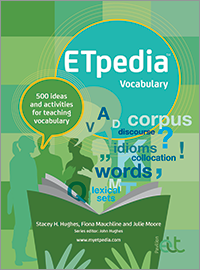ETpedia Vocabulary: combining knowledge
When I was asked to be involved in writing the new ETpedia Vocabulary book, it was a no-brainer. Having started my ELT publishing career working on learner's dictionaries, although I've branched out into writing a whole range of different types of materials, vocabulary is still my first love.
For those of you not familiar with the ETpedia titles, they're resource books aimed at teachers, each of which contains 500 short teaching tips around a particular topic; young learners, exams, Business English, etc. There are 10 books in the series so far and ETpedia Vocabulary is the latest.

Drawing on a mix of expertise:
I co-wrote the book with Fiona Mauchline and Stacey H Hughes, making a writing team who brought very different skills and perspectives to the party. Our different areas of expertise came out right from the very first meeting in which it turned out to be surprisingly easy to divide up the chapters we'd sketched out for different areas of vocabulary teaching. Fiona is an expert in teaching teenagers, she has a fascinating knowledge of the psychology and neuroscience of language learning and she's full of ideas for sparking creativity. Stacey has a background in teacher training and seemed to come up with an endless supply of varied and creative practical classroom activities and tools. She made me think more about all the stuff that doesn't (and can't) appear on the pages of coursebooks, but goes on in classrooms amongst teachers and learners. For my part, I was happy to fill the language nerd role focusing on explaining terminology, looking a dictionary skills, corpus tools and some of the nitty-gritty of morphology and lexicogrammar. I think our different inputs have led to a fabulously rounded resource which will be relevant to lots of different contexts and appeal to teachers with different teaching styles.
I should also add that blending the input from the three of us, dealing with the inevitable overlaps and differences in style was no mean feat, but was ably handled by crack editor Penny Hands and the guiding hand of series editor John Hughes.
Digging deeper into my own knowledge:
The actual writing process was an interesting challenge and quite different from my usual work of writing classroom materials. It forced me to dig around in my brain and think about the why and the how of vocabulary teaching rather than just the what. It allowed me to rove around all the different aspects of vocabulary teaching that I've touched on over the past 20 years or so. It prompted me to go back and read up again on a whole range of areas, as well as checking out the latest developments in corpus tools and other online vocabulary resources. And inevitably, it left me with way more I wanted to say than would fit into the ETpedia style of short, concise teaching tips! At times, that was frustrating, but it was also a great exercise in trying to pick out the key ideas that were really worth passing on and cutting the waffle.
I hope the resulting book will be a useful resource for teachers to dip into and flick through when they're short on inspiration and want to try something new, when the way they approach vocabulary is perhaps feeling a bit stale and repetitive, or when they're tackling a different type of class (EAP, advanced learners, students with dyslexia or colour-blindness). I certainly picked up lots of great ideas from my co-authors in the process of writing the book and re-invigorated my own approach to vocabulary teaching.
Originally posted on Lexicoblog. Reproduced with the kind permission of Julie Moore.
Comments
Write a Comment
Comment Submitted